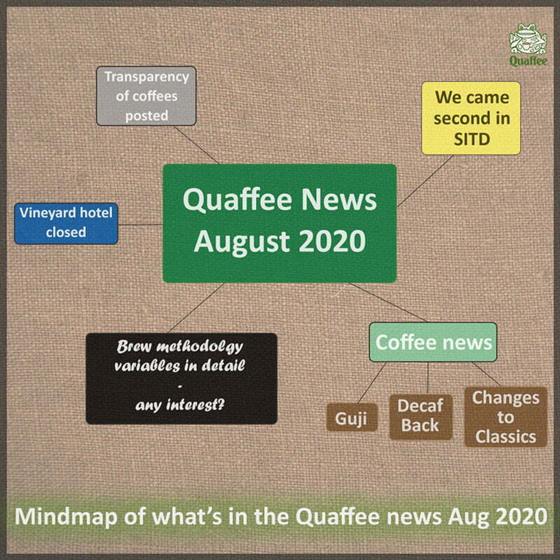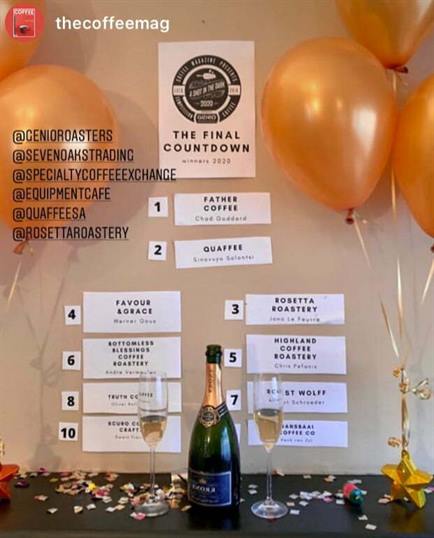Intro
Last time we posted a mind map of what is in our newsletter, and people loved it. It seems most people prefer the mind map version of the newsletter – so here is another

If you are unable to see the image, here is a summary in point form:
- Quaffee came second in the national roasters’ competition called Shot in the Dark.
- Transparency information for each coffee is now on the website.
- Coffee News:
- New Guji – info here…
- Decaf back – info here…
- Two blends change Bunna and Wildly Organic (click names for more info)
- Is there any interest in the variables WRT coffee brew methodologies?
- While the Vineyard Hotel is closed until further notice, we are still offering coffee from the roastery.
If you want to read more, the door to that cupboard can be opened below.
Placing Second in SITD 2020
You made it here? Settle in we are expecting a bumpy ride.
In 2018 the South African coffee magazine started a roaster competition. Initially, the competition was by invite only. The premise: they supply a coffee, the competing roaster roasts that coffee their way. Coffees are then cupped and tasted in espresso form to determine the winner.
In 2018 we came joint third. The field was small, and there was only one round. In 2019 we also competed but did not make the top 10. I (as in me, Warren Machanik) blame myself for this, rather than Mzukisi who roasted that year. Since I was fixated on submitting a coffee that I liked, and I wanted it to be cupped within 48 hours of roasting. Obviously, this was a mistake. As a result of competing, Mzukisi went to Durban for the Coffee Creative Week and was able to visit Beaver Creek coffee farm.
So, when the competition was announced this year, I asked Sino if he wanted to compete, and he was keen. Days after the coffee for the SITD arrived, lockdown happened. We had no access to Sino’s roaster in the Vineyard Hotel, but we still had to submit a coffee. Sino had to then roast on the Buiten roaster. We met one Saturday to roast the coffee we had been provided (knowing only that it was a washed Guatemalan). We cupped the coffees via phone the following Monday, to determine which of the basic profiles we liked. Once we knew which we like, then had to meet again and roast the coffee with small tweaks in the basic profile, including going darker than we usually would. Once again, we had to remotely cup the coffees to determine the one we liked. Again, we choose one that we liked over the more “developed” coffee. We then assessed when it tasted best. This coffee seemed most delicious between 12 and 16 days. So 14 days before the coffees were assessed Sino went into Buiten to roast the coffee as per the profile we liked. We submitted it via road freight (not a fan of airfreight and what it does to coffee).
If you had not guessed, we made top 10 (only just we were joint 9th, out of almost 50 roasters).
Now we were sent two more coffees. One to roast and submit as a single origin (a Rwandan). An additional Ugandan, as well as the original coffee. By this time, we had access to the Vineyard roastery. So, Sino repeated the same process as we had done before, but with the three coffees. I popped in to collect the coffees. We then once again cupped via phone.
Using the feedback we received from the judges for the first round, we looked for a coffee they would like. Once we had an idea what that was, Sino felt that we should submit a coffee that was more developed then we typically do. We had to use the Ugandan in the blend, even though for us it was past its best (way past actually), so really extended its development.
Once we had the three coffees where we felt they were to the judges’ liking, we then had to play with the blend, which was to be used in the espresso part of the comp (which counts 25%). After playing, we decided on a blend that would mute the fruity flavours of the Rwandan. Next was determining the recipe for the espresso. After playing with the grinder, the dose and yield, we selected an espresso with reduced acidity (or sourness for some) and had some sweetness. And once again we found the coffee seemed best at around 14 – 16 days.
Out of interest with regard to blending, many coffee people are concerned about extraction percentage per coffee or matching the solubility of each coffee. Having played with these before, I have learnt the best thing to do is to blend the brewed coffee like they do with wine. This is how we blended these coffees.
Typically, the finals of the competition are held at Coffee Creative Week. With COVID-19 restrictions in place, the coffee mag revealed that they would be announcing the results via Instagram live video. Monday they announced 10-9-8, Tuesday 7-6, Wednesday 5-4 and then Thursday 3-2-1. On Monday when we were not included in the first three, we were surprised. On Tuesday, when we were in the top 5, we were elated. By the end of the announcement on Wednesday, we were so excited to be in the top three. We organised for all of us to be with Sino for the announcement (breaking some COVID-19 social distancing rules, but 14 days later we are good 😊).

On the Thursday Mel and Iain interviewed the top 3, in a random order. Jono from Rosetta spoke, then Chad from Father coffee and then Sino was interviewed. They then announced that Rosetta had come third; we had come second, and that meant Father had won. To be in the top 3 with Father and Rosetta was special. Coming second was a bonus.
Congratulations to Sino, he has only been roasting for just over 2 years. We are proud of him and how he has gone from being the person who helped with your machines and delivered your coffee, to the roaster he is today.
To make top 3 was remarkable, and then to come second was a wonder.
Transparency information published
We became aware of the initiative being driven by transparency.coffee in May. As a result of this initiative, we have published transparency information about all our coffee on each coffee page. We also have put together a summary of this information on a single page on our website. You can access this page on the About menu or click Coffee Transparency at the bottom of the page.
Is this of interest to you? Are we just barking mad? Or are we barking into the wind?
Coffee News
If you follow us on social media (where we have reduced our presence to a minimum), you would have seen us publish that the coffee from Guji is here. Guji is a relatively new region to specialty coffee and has grown in popularity in the last decade. We visited the area in 2016 and found that there was a high number of processing stations preparing naturals. We have selected one from the Arsosala processing station. Check the details out online here…
It’s back! For those that have been waiting, the La Serrania decaf is back in stock. Rand weakness and the logistics prices have resulted in the coffee being a little more than it was before. That said we are happy to have this popular coffee back. Read more…
Two of our classic blends have changed. Change, in this case, has been driven by the coffees we are currently sourcing. Firstly, our very popular Eastern African Blend “Bunna” has changed. Bunna, which is our blend of the specialty coffees we currently have from Eastern Africa, has been updated. All the goodness of the four coffees makes this a sweet and fruity blend. As the ingredients have increased in price, so too has the price of this popular blend. More info…
Wildly Organic is the other blend to have a facelift. Limu has been its cornerstone since the beginning. With us no longer sourcing Limu we have changed this blend. We love the result, and like its predecessor, it works well with milk and on its own. Read all about it here…
Anyone interested?
There has been an explosion of brew guides on the internet, and specifically on YouTube. These guides deal with all types of brew methods and usually focus around the triage of D-Y-T, or Dose, Yield and Time.
While DYT is a great way to assess a brew, for us many other variables make a coffee brew a little more complicated. For those who have made it this far in the newsletter, you are the target here. We started including a lot of coffee information in our newsletters. This stuff takes a lot of work to put together. The previous newsletter discussed how we source coffee. We have had zero feedback on it. So before we go into the methodology around assessing the variables of brewing, we thought we would ask first. If we get any takers, we will look at doing a collection of brewing methodology posts. Do you prefer blog posts or YouTube videos? We would like to know. No response will mean we will refrain from littering the internet with this stuff. Simply us the contact us form or email us directly.
As a taster here are some variables we want to discuss:
- Around water:
- Temperature at brew
- Pressure at brew
- Method water added (blooming / pre-brew) and additional water
- Pouring variables (for espresso screens and for others how is the water poured, rate and shape)
- Grinding: fine or course, what is the effect?
- Dose and Yield wrt to the final taste
- Filtration: paper, cloth or mesh (some work already published about this)
We await feedback.
Vineyard Hotel
The Vineyard Hotel has essentially stayed closed through the COVID-19 lockdown. While they now offer take away coffee, the restaurants are closed. If you are not a guest, access to the hotel is severely limited.
We have decided to still roast there once or twice a week. It all depends on what is ordered either on the website or via other ordering channels. Expect additional delays in the orders. We are looking for alternatives. Are you looking to rent some roasting time, or want to just have fun roasting coffee? We are entertaining any offers at the moment wrt to the roastery at the Vineyard. The management team have not kept us fully informed. However, with the situation as it is we cannot see the hotel returning to normal until around mid next year.

